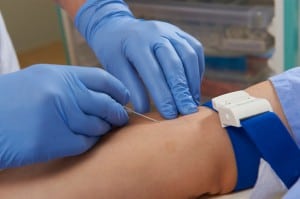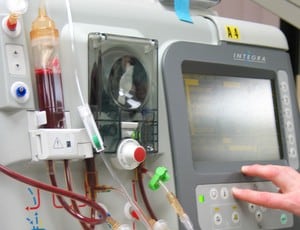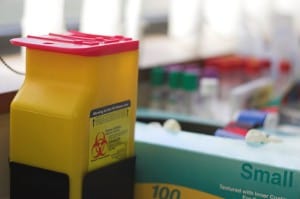Education and devices to prevent blood and body fluid exposures

Despite recent technological advances such as safety-engineered devices (SEDs), these injuries continue to occur in healthcare facilities worldwide” Cheetham et al (2019). Abstract: BACKGROUND: Healthcare workers are at risk of blood and body fluid exposures (BBFE) while delivering care to patients. Despite recent technological advances such as safety-engineered devices (SEDs), these injuries continue to occur […]
Propionibacterium acnes osteomyelitis after intraosseous cannulation

We report here an extremely rare incident of P. acnes tibial osteomyelitis at the IO access site” Cole et al (2019). Abstract: Propionibacterium acnes osteomyelitis secondary to intraosseous (IO) cannulation is not well documented in literature. We report here an extremely rare incident of P. acnes tibial osteomyelitis at the IO access site, in a […]
How to reduce pain during venipuncture in premature infants

To evaluate the efficacy of the reduction of visual and auditory stimuli on pain during venipuncture in premature newborns of 32-36 weeks of gestation” Bonjorn Juarez et al (2019). Abstract: AIM: To evaluate the efficacy of the reduction of visual and auditory stimuli on pain during venipuncture in premature newborns of 32-36 weeks of gestation. […]
Central venous access device removal in children

To assess the utility of routine preprocedural bloodwork during elective removal of central venous access devices (CVADs) with respect to bleeding complications” Donnellan et al 92019). Abstract: PURPOSE: To assess the utility of routine preprocedural bloodwork during elective removal of central venous access devices (CVADs) with respect to bleeding complications. MATERIALS AND METHODS: Patients who […]
Accessing medical care following needlestick injury

First responders have an increased risk of occupational exposure to HIV as the result of a needlestick injury (NSI) because of the chaotic prehospital environment in which they provide care” Carter et al (2019). Abstract: First responders have an increased risk of occupational exposure to HIV as the result of a needlestick injury (NSI) because […]
Outcomes of outpatient parenteral antibiotic therapy

HRQoL at baseline was significantly associated with lower risk of complications and early OPAT termination, as well as greater likelihood of return to work while on OPAT” Wee et al (2019). Abstract: While health-related quality of life (HRQoL) is an important component of patient-centred care, few studies have looked at the association between HRQoL and […]
Survey of non-resuscitation fluids administered during septic shock

The objective of the study was to quantify and characterize non-resuscitation fluid administered to patients with septic shock” Lindén-Søndersø et al (2019). Abstract: Background: The indication, composition and timing of administration of non-resuscitation fluid in septic shock have so far received little attention and accordingly the potential to reduce this source of fluid is unknown. […]
Simultaneous placement of leadless pacemaker and dialysis catheter

The described case emphasizes the necessity of multispecialty collaboration and gains of new pacing technology in patients who need placement of vascular access for hemodialysis and cardiac implantable electronic device where vascular access is scarce” Bednarczyk et al (2019). Abstract: The problem with limited venous access may occur in patients receiving long-term hemodialysis treatment with […]
Early cannulation of percutaneously created AV hemodialysis fistulae

The results of this study suggest that the possibility of successful early cannulation with a percutaneous arteriovenous fistula can be considered as an additional factor in making this access a reasonable alternative for a surgically created arteriovenous fistula in appropriate patients” Mallios et al (2019). Abstract: INTRODUCTION: The optimal vascular access for most dialysis patients […]
Hospital-based CLABSI prevention program

Fourteen CLABSIs were reported in the 17-month period prior to the implementation of the program, while no new CLABSIs occurred in the 30 months following implementation of the program” Conwell et al (2019). Abstract: Central venous catheter (CVC) vascular access is common among patients on hemodialysis. CVC use carries a substantial risk of central line-associated […]
Ultrasound-guided or landmark technique for CVC insertion

The real-time USG guided technique significantly reduces the number of attempts to cannulate, has a higher first-pass success rate, a quicker flash time, and fewer complications when compared to the AL technique” Kunhahamed et al (2019). Abstract: BACKGROUND AND OBJECTIVES: Central venous catheter placement is a frequently performed procedure in emergency medicine as well as […]
Effect of Epinephrine infusion on survival in critically ill patients

Current randomized evidence showed that continuous IV administration of epinephrine as inotropic/vasopressor agent is not associated with a worse outcome in critically ill patients” Belletti et al (2019). Abstract: OBJECTIVES: Epinephrine is frequently used as an inotropic and vasopressor agent in critically ill patients requiring hemodynamic support. Data from observational trials suggested that epinephrine use […]
Creative attitude toward hemodialysis access

Creating and maintaining a functional vascular access (VA) is a critical factor in the survival of a dialysis patient” Sousa et al (2019). Abstract: Creating and maintaining a functional vascular access (VA) is a critical factor in the survival of a dialysis patient. It implies a creative attitude either to maintain its functionality or to […]
Infusion-related reactions during Natalizumab treatment

Although NTZ is usually well-tolerated, infusion-related reactions (IRRs) may occur, and the patients have to be monitored during the infusion and for one hour afterwards” Sacco et al (2019). Abstract: BACKGROUND: Natalizumab (NTZ) is a humanized monoclonal antibody used in the treatment of relapsing remitting multiple sclerosis. Although NTZ is usually well-tolerated, infusion-related reactions (IRRs) […]
PICC placement via upper versus lower extremity veins

To investigate the effect of placement of peripherally inserted central catheter (PICC) via the upper versus lower extremity veins in neonates through a Meta analysis” Chen et al (2019). Abstract: OBJECTIVE: To investigate the effect of placement of peripherally inserted central catheter (PICC) via the upper versus lower extremity veins in neonates through a Meta […]
Diagnostic blood loss from phlebotomy and hospital acquired anemia

The study was performed to estimate the diagnostic blood loss (DBL) volume during hospitalization and investigate its relationship with the development of moderate to severe hospital acquired anemia (HAA) and increased number of red blood cell (RBC) transfusion following extensive burns” Yao et al (2019). Abstract: PURPOSE: The study was performed to estimate the diagnostic […]
Consumer audit of home parenteral nutrition training

Published guidelines recommend patients and carers are trained and meet competency in certain criteria of connecting and disconnecting procedures before discharge from hospital on home parenteral nutrition (HPN)” Winterbourn et al (2019). Abstract: Introduction: Published guidelines recommend patients and carers are trained and meet competency in certain criteria of connecting and disconnecting procedures before discharge […]
Current science and perspectives on granulocyte transfusions

Since the 1960s, granulocyte transfusions have been used to either treat or prevent serious infections in patients with neutropenia or neutrophil dysfunction” West and Conry-Cantilena (2019). Abstract: Severe neutropenia renders patients susceptible to life-threatening bacterial and fungal infections. Despite improvements in supportive care and antimicrobial therapy, morbidity and mortality remains significant. Since the 1960s, granulocyte […]
Assessment of dextrose 50 bolus versus dextrose 10 infusion

In our study, D10 infusions appeared to be at least as effective as D50 bolus in preventing hypoglycemia in hyperkalemic patients receiving IV insulin” Yang et al (2019). Abstract: INTRODUCTION: Hypoglycemia is a common adverse effect when intravenous (IV) insulin is administered for hyperkalemia. A prolonged infusion of dextrose 10% (D10) may mitigate hypoglycemia compared […]
Taurolidine antiseptic for CLABSI prevention

Taurolidine is a broad-spectrum antiseptic used as lock therapy solution in adult and pediatric patients with long term central venous catheters (CVC) for the prevention of catheter related bloodstream infections (CRBSI)” Haro (2019). Abstract: Taurolidine is a broad-spectrum antiseptic used as lock therapy solution in adult and pediatric patients with long term central venous catheters […]
Comparison between approaches to ultrasound-guided implantable port placement

To compare the efficacy and safety of right internal jugular vein (IJV) approach and right innominate vein (INV) approach for US-guided totally implantable venous access devices (TIVADs)” Sun et al (2019). Abstract: BACKGROUND: To compare the efficacy and safety of right internal jugular vein (IJV) approach and right innominate vein (INV) approach for US-guided totally […]
Defined strategy for intraosseous devices in small children

Our study shows that the current procedure for establishing an intraosseous access in infants and children should also be critically reviewed” Maxien and Wirth (2019). Extract: We are grateful for the important remarks by Dr Bouchut and colleagues. The letter highlights a highly relevant and interesting aspect of the topic. The saying “children are not […]
Evaluation of the first 5 minutes of emergency department resuscitation

The aim of the study was to describe the performance data of emergency department (ED) teams who performed CPR in a pediatric ED” Grimsley et al (2019). Abstract: OBJECTIVES: Effective leadership and teamwork are imperative during pediatric cardiopulmonary resuscitations (CPR). The initial phase of pediatric CPR, termed the “first 5 minutes,” has significant care delivery […]
Central line utilization following standard feeding roadmap in NICU

Implementation of a standardized feeding roadmap was associated with a reduction in days to first enteral feeds, an increase in the primary use of human milk for initiation of enteral feeds, and a decrease in the utilization of central lines while improving weight gain in very low-birth-weight infants” Kohler et al (2019). Abstract: BACKGROUND: Before […]
Comparative efficacy and safety of IV lock solutions

To assess the most appropriate lock solution for central venous catheters to prevent catheter-related bloodstream infections and other complications” Sheng et al (2019). Abstract: Background: Central venous catheters are used extensively as temporary or permanent vascular access for hemodialysis patients. Catheter-related bloodstream infections are the main complication of central venous catheters and increase morbidity and […]
Guidelines and protocols for subcutaneous hydration

To evaluate the availability of, adherence to, and perceived usefulness of guidelines and protocols for managing hydration and subcutaneous hydration in palliative care settings” Cabañero-Martínez et al (2019). Abstract: AIMS AND OBJECTIVES: To evaluate the availability of, adherence to, and perceived usefulness of guidelines and protocols for managing hydration and subcutaneous hydration in palliative care […]
Inferior vena cava syndrome in neonates

This review comprised 61 neonates across 33 reports. Thrombosis occurred in 98% and 42% involved a central venous catheter” Tieu et al (2019). Abstract: Neonatal inferior vena cava syndrome (IVCS), though uncommon, is associated with significant morbidity and mortality. Information on risk factors, diagnosis, treatment, and outcomes is limited. This review comprised 61 neonates across […]
Aerobic-only blood cultures for routine detection of bacteraemia

Sampling practices determine the accuracy of blood culture in diagnosing bloodstream infection. Our main acute hospital introduced aerobic-only routine blood cultures aiming to increase the volume and number of aerobic samples” Stoneham et al (2019). Summary: Sampling practices determine the accuracy of blood culture in diagnosing bloodstream infection. Our main acute hospital introduced aerobic-only routine […]
Standard of care following extravasation of chemotherapy drugs

The recommended procedures will contribute to reducing the risk and consequences of extravasation” Vokurka et al (2019). Abstract: BACKGROUND: Extravasation (paravasation) of chemotherapy drugs is a very significant complication in the treatment of cancer patients. Preventive and therapeutic interventions reduce the risk of this complication or the extent of its consequences. A working group of […]
Designated nurse PICC teams and CLABSI prevention

These data suggest that nurse PICC teams play an integral role in PICC use at many hospitals and that use of such teams may promote key practices to prevent complications” Krein et al (2019). Abstract: Objectives: The use of peripherally inserted central catheters (PICCs) has increased substantially within hospitals during the past several years. Yet, […]

